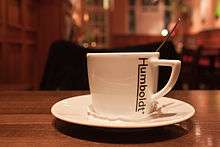Restaurant ware

Restaurant ware, or most commonly hotelware[2][3][4][5][6][7][8] is vitrified, ceramic tableware which exhibits high mechanical strength and is produced for use in hotels and restaurants.[9] Tableware used in railway dining cars, passenger ships and airlines are also included in this category.
Collectable hotelware was usually made of stoneware or ironstone china during the early to mid-20th century. Examples from the 19th century are also collectable, but rarer.
History

Hotelware was produced by the same potteries that produced domestic ware. As the middle class grew during the late 19th century, dining out became an affordable option for more people with disposable income. The number of restaurants, and mass transportation such as ships and railways with dining facilities, led to a greater demand for hotelware. Stoneware and ironstone ware were popular choices for restaurants for their ability to withstand heavy use. Transfer designs also enabled some restaurants to set their tables with pieces bearing the business name or emblem. By the early 20th century, hotelware expanded into diners catering to road travellers, and airlines also introduced on board meals served on hotelware.
United States
Homer Laughlin, the largest pottery in the United States for much of the 20th century, first began producing hotelware in 1959, but by 1970, it ended its production of household porcelain.[10] Homer Laughlin produced hotelware exclusively until the revival of interest in Fiesta Ware led to its reintroduction to its product lines.[11] Although not ceramic and not generally considered hotelware, from 1950 to 1956 Anchor Hocking produced Fire King Jadeite ware that was aimed at catering establishments .[12]

The hotelware industry in the United States faced many challenges beginning in the late 1980s. Following the economic downturn of 1987 and the 1990s, restaurants were hit hard by a decline in consumer spending and demand for hotelware declined by 20%.[13] At the same time, Americans consumed fast-food in disposable containers at an increasing rate, putting more pressure on the US hotelware industry.[14] By the early 21st century, Syracuse China, which had for decades been a major producer of hotelware, ended manufacture in the US and outsourced production overseas.[15]
Production
Since hotelware is subject to heavy use, it is made to resist chipping and cracking rather than emphasizing aesthetic qualities over utility. Whereas bone china is fired at near its melting point when it is produced, hotelware is not.[16]
Manufacturers
- Colombia - Corona[17]
- Czech Republic - Pirken-Hammer[18]
- Germany - Eschenbash,[19] Hutschenreuther,[20] Villeroy & Boch[21]
- Indonesia - Royal Doulton[22]
- Japan - Noritake[23]
- Luxembourg - Villeroy & Boch[24]
- Sri Lanka - Noritake[25]
- United Arab Emirates - RAK Porcelain[26]
- United Kingdom - Dudson,[27][28] Royal Doulton[29]Steelite[30] & Wedgwood.[31]
- United States - Syracuse China, Buffalo China Company,[32] Iroquois China Company, Homer Laughlin[33] & Anchor Hocking.[34]
Related collectables
Vintage fast food ware, such as "beehive" glass condiment containers, is also collectable, and several United States manufacturers and vintage dealers also market reproductions of vintage styles.
See also
References
- ↑ Dictionary of Ceramics (3rd Edition), ed by: Arthur Dodd, & David Murfin. Maney Publishing 1994
- ↑ ‘Serving Suggestions. Asian Hotelware Finds Its Place At The Table.’ R.Ware. Asian Ceramics. February,2011
- ↑ 'South East Asian Hotelware.' Asian Ceram. October, 2008. Pg.41,43,45,47,49
- ↑ ’Can Retailers Profit From Hotelware?’ R.Weightman. Tableware International 22. No.1. 1992. Pg.158-161.
- ↑ ‘Porcelain Tableware Of High Strength - Properties And Microstructure’ R.Rubin, C.Hahn. Sprechsaal 116, (10), 874, 1983.
- ↑ ‘Resistance Of Hotelware Glazes To Attack By Commercial Dishwasher Agents.’ A. Scowcroft, S.Salt, W.Roberts. British Ceramics Research Association. Research Paper 710, 1980.
- ↑ 'An Introduction to the Technology of Pottery.' (2nd edition.) Paul Rado. Institute of Ceramics & Pergamon Press. 1988.
- ↑ ‘Whitewares: Testing and Quality Control’ W.Ryan, C.Radford. Institute of Ceramics & Pergamon Press. 1987.
- ↑ Dictionary of Ceramics (3rd Edition), ed by: Arthur Dodd, & David Murfin. Maney Publishing 1994
- ↑ Page, Bob; Dale Frederiksen & Dean Six (2003). Homer Laughlin: Decades of Dinnerware. Page/Frederiksen Publishing Company. p. 13. ISBN 9781889977133.
- ↑ Page, Bob; Dale Frederiksen & Dean Six (2003). Homer Laughlin: Decades of Dinnerware. Page/Frederiksen Publishing Company. p. 13. ISBN 9781889977133.
- ↑ Schroy, Ellen T. (2009). Warman's Depression Glass: Identification and Value Guide. Krause Publications. p. 124. ISBN 9780896899537.
- ↑ Reed, Cleota & Stan Skoczen (1997). Syracuse China. Syracuse University Press. p. 170. ISBN 9780815604747.
- ↑ Reed, Cleota & Stan Skoczen (1997). Syracuse China. Syracuse University Press. p. 170. ISBN 9780815604747.
- ↑ Reed, Cleota & Stan Skoczen (1997). Syracuse China. Syracuse University Press. p. 170. ISBN 9780815604747.
- ↑ Wachtman, John B. (2009). 1994 Ceramic Manufacturers and Suppliers Worskhop: Ceramic Engineering and Science Proceedings, Volume 16, Issue 3. John Wiley & Sons. p. 132. ISBN 9780470316337.
- ↑
- ↑ ‘Czechoslovakian Ceramics Industry: A Major Contributor To The Economy’ American Ceramic Society Bulletin 70. No.4. 1991. Pg.681-683
- ↑ ‘Eschenbach. Investing In Technology’ Tableware International 20. No.11. 1990
- ↑
- ↑ 'Villeroy & Boch's Uk Consolidation' Tableware International 26, No.5. 1996. Pg.17-18
- ↑ 'All Aboard For Indonesia - Royal Doulton Closes Final UK Operations'. Asian Ceramics May 2004.
- ↑ 'Noritake Investment Grows In Sri Lanka'. Tableware International 22. No.7. 1992. Pg.12
- ↑ 'Villeroy & Boch's Uk Consolidation'Tableware International 26, No.5. 1996. Pg.17-18
- ↑ 'Noritake Investment Grows In Sri Lanka'. Tableware International 22. No.7. 1992. Pg.12
- ↑ 'South East Asian Hotelware.' Asian Ceram. October, 2008. Pg.41,43,45,47,49
- ↑ ’Can Retailers Profit From Hotelware?’ R.Weightman. Tableware International 22. No.1. 1992. Pg.158-161.
- ↑ ’Family Of English Potters Since 1800’ Dudson:Centennial of Fine Hotel Tableware 1891-1991 London. 1991.
- ↑ 'Changes At Royal Doulton'Ceramic Technology International 1997. Sterling Publications Ltd. 1996
- ↑
- ↑
- ↑
- ↑ Page, Bob; Dale Frederiksen & Dean Six (2003). Homer Laughlin: Decades of Dinnerware. Page/Frederiksen Publishing Company. p. 13. ISBN 9781889977133.
- ↑ Schroy, Ellen T. (2009). Warman's Depression Glass: Identification and Value Guide. Krause Publications. p. 124. ISBN 9780896899537.